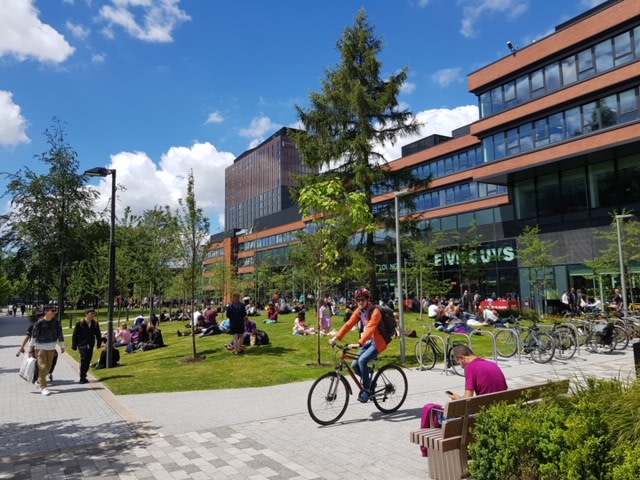How can we build back better through sustainable transport
By Bruntwood Works

Ensuring cities are sustainable is a key part of every city's agenda as we look to build back better after the pandemic. But for any city to be truly sustainable, it needs a sustainable transport system, too.
How we adapted our travel over lockdown
The way that our towns and cities were once planned, cars were put at the centre. Over the last ten years, we’ve seen priorities change with more cycle routes, public transport and walking options become available. But there is still further to go.To help make sustainable ways of travel more accessible and appealing, it’s important that we reprioritise and rebalance our streets to make it easier for people to walk, cycle or take public transport.
Over the course of the pandemic, we’ve seen increases in cycling and walking provisions across the country, proving that when given the incentive to innovate, we can adapt our streets and roads to support more active travel modes through new approaches to make rapid change.
How sustainable transport can help us to build back better
While crucial to the recovery and the future of our planet, sustainable transport isn’t just about the impact that it can have on our carbon footprint as a country and its impact on the climate crisis.
How we move around our towns and cities will be key to not only a greener country, but a fairer society, too. As outlined by Sustrans in their latest Bike Life report, as a country, we are currently facing inequity, the climate crisis, air pollution, physical inactivity, community severance, road collisions, congestion, high street crisis and economic stagnation.
By transforming our transport systems, supporting easier and safer access to walking and cycling routes, as well as improving public transport, we will be able to reduce societal and health inequalities, improving economic resilience and wellbeing for everyone.
These matters are all firmly on the agenda as we ease our way out of lockdown and look to build back better after the pandemic. Ultimately, cycling and walking are good for people; for our physical health, our wellbeing and our enjoyment.
Support for sustainable transport
According to the latest Bike Life report, over two thirds of people support building more cycle tracks, even if this would mean less room for other road traffic and 58% would like to see more government spending on cycling.
Across our cities, cycling has a major impact on people, the environment and the economy:
In Greater Manchester, up to 45,000 cars are taken off the road every day by cycling £3.5m is saved each year for the NHS by cycling in the Liverpool city region And cycling creates £94.9 economic benefits to individuals and the Liverpool region In the West Midlands, 23,000 tonnes of greenhouse gas emissions are saved every year by cycling. And those are just a few of the benefits that our regions are seeing.
How we’ve made sustainable transport easier for our customers and colleagues
Making it easy for our customers and colleagues to keep active and take more sustainable modes of transport has always been important to us. We’ve focussed on encouraging active commutes and ensuring our buildings are well equipped to support that.
Over 75% of our buildings have secure bike storage, lockers and shower facilities so customers and colleagues don’t need to worry about the safety of their personal items or a potentially rainy journey.
Jessica Bowles, director of strategy at Bruntwood, said: “Across the country, we have seen huge strides made in supporting people to return to the city with the introduction of new cycle routes, pop up cycle lanes, and socially distanced walkways. For example, in Manchester we’ve seen this built through Chris Boardman, the Mayor's adviser on active travel's ambitious Bee Network programme.
“We can play a big role in supporting the thousands of people across our cities to return to the workplace actively and safely but also sustainably in line with the government's desire for a green recovery.
“Our goal is to help make sustainable travel more accessible so that many more people feel confident about commuting into the city without their cars or on public transport, and at the same time can look after their physical and mental wellbeing.”
Last September, as many people returned to offices after long periods of working from home, we saw an increase in those choosing to cycle, walk, run or even scoot to work. That’s why we brought ‘Active Travel Hubs’ to many of our buildings, for both our customers and the general public, to help people return to work safely.
Working with our partners, Active Travel Hub visitors were able to get expert advice and resources on the options available for active travel, as well as having the opportunity to get a health check for their bicycle so they know it’s ready to go when they are.
The Travel Hubs will soon be making a comeback, so you can prepare for greener, healthier travel around your community.
Stay Connected!
Sign up to our newsletter for the latest news, updates and offers.